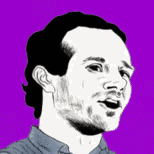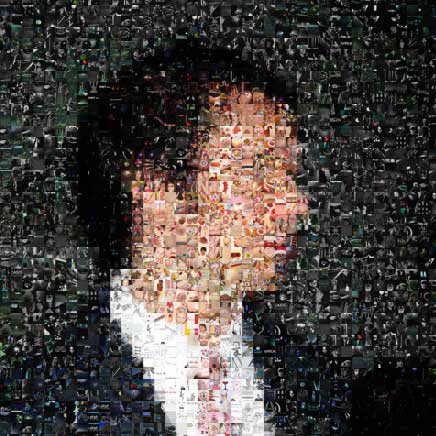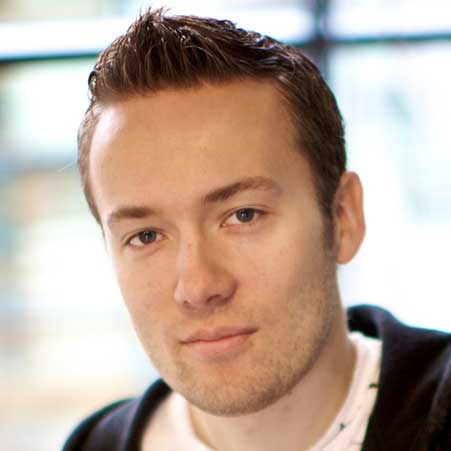A beautiful speech on Father’s Day in Chicago by Barack Obama. Wherever you fall politically, give this talk about family, responsibility, expectations, and ambition a listen. There’s a bit of politics and religion in the last few minutes, but the underlying message is universal. Happy Father’s Day.
Made in...
Patience as a design principle
One of my intellectual heroes, Ronald Langacker, recently released a new book which summarizes his 30-year-old program of Cognitive Grammar, a radical and insightful approach to understanding language. In the very beginning of the book, Langacker outlines three principles which guide his work.
Integration means his explanations about language shouldn’t stand alone from our understanding of how the brain works or how psychology works. He wants his analyses to fit with neighboring disciplines instead of standing in their own tower.
Naturalness is his second principle. It means that a really good explanation should be reasonable and understandable. If an explanation is arcane, artificial, or exotic, it’s probably wrong.
Patience is an unexpected final principle. Being sure not to put the cart before the horse, it means withholding judgment on questions that are premature. As software designers, this means developing a “wait and see” approach that doesn’t indulge in too much speculation. Most feature ideas are speculative. “Wouldn’t it be cool if (x)” is very different from saying “for the last two weeks I’ve been frustrated by (y).” Having patience means putting speculative ideas on a shelf until actual life experience proves they have benefit. Launching a product with “too few” features is a kind of patience. Keeping your team small is a kind of patience.
At 37signals, we focus on lean features, short iterations, quick wins, small improvements, and the satisfaction of “build and release.” Paradoxically, all this quick movement and quick satisfaction rests on a foundation of patience. Most of our ideas are never implemented. Our products are never finished. Doing what’s in front of your nose, doing smart work that makes an impact today and leaves space for changes tomorrow takes patience. I’m glad Langacker’s book pointed this out.
Product Blog update: Import RSS feeds into Basecamp, Virb can't imagine life without Campfire, etc.
Some recent posts at the 37signals Product Blog:
Basecamp
Import RSS feeds into Basecamp with telegraph
Using telegraph you can import RSS or Atom information from other systems into your Basecamp account.
fixx is a new bug tracking and issue tracking system for software teams that integrates with Basecamp
“fixx integrates with Basecamp by allowing you to import your existing projects, milestones and users. This allows you to kick-start your usage of fixx and re-use existing project information, without having to spend your valuable time replicating data that you already have in use.”
Variety Club of Great Britain uses Basecamp to help disadvantaged children
For more than 50 years, Variety Club Children’s Charity has been helping sick, disabled and disadvantaged children in Great Britain. They recently began using Basecamp and Chairman Len Keighley wrote to tell us how much it’s helped.
Campfire
Virb can’t imagine life without Campfire
“I honestly can’t see how our team ever did without it. Campfire is open in a browser tab all day long. It’s launched when the day begins on the east coast and isn’t closed until the last left coast’er signs off in the evening. We fire-up iChat for group audio chats several times a day, but otherwise, no project communication happens outside of ‘the campfire’.”
"You have to treat your employees like customers"
SvN reader Michelle posted this comment in the best customer experience you’ve had lately thread:
Several weeks ago I ran out of cash at the Farmers’ Market. After sampling some goat cheese I told the vendor I’d definitely buy some the next week because I’d ran out of cash that day. She said “take it home today and pay me next week.”
It’s not surprising that a vendor at a Farmers’ Market would behave that way but it was still so refreshing to just be trusted as a consumer. It seems like so many businesses/vendors think consumers are “trying to get one over” on them. Naturally the goat cheese lady now has a loyal customer for life.
It occurred to me the exact same concept applies to workplaces too. Just swap out the word employee for customer. When employees are trusted and treated like adults, they appreciate it just as much. The result: loyal employees who want to stick around forever.
The secret to Southwest’s success
Southwest Airlines founder Herbert D. Kelleher has a similar theory. He says, “You have to treat your employees like customers.” His final meeting as head of Southwest shows what an employee-centric management style can create…
When Mr. Kelleher, 77, entered the main meeting room, shareholders gave him the kind of standing ovation usually reserved for rock stars. The Southwest pilots union is also in the process of negotiating a new contract with management. But not only did the Southwest pilots not set up a picket line, they took out a full page ad in USA Today thanking Mr. Kelleher for all he had done. “The pilots of Southwest Airlines want to express our sentiment to Herb that it has been an honor and a privilege to be a part of his aviation legacy,” said the union president, Carl Kowitzky, in a statement…
But when he brought up the pilots ad — and when he talked about how much the company’s employees meant to him — he wept. “I’m Lucky Herbie for having all of these years with all of you,” he said. More than a few people in the audience wept right along with him.
No surprise there, either. Over the years, whenever reporters would ask him the secret to Southwest’s success, Mr. Kelleher had a stock response. “You have to treat your employees like customers,” he told Fortune in 2001. “When you treat them right, then they will treat your outside customers right. That has been a powerful competitive weapon for us.” As he stepped away from the company this week, his line didn’t change.
“We’ve never had layoffs,” he told me the day before the annual meeting, sitting on the couch of the single messiest executive office I’ve ever seen. “We could have made more money if we furloughed people. But we don’t do that. And we honor them constantly. Our people know that if they are sick, we will take care of them. If there are occasions or grief or joy, we will be there with them. They know that we value them as people, not just cogs in a machine…”
“There isn’t any customer satisfaction without employee satisfaction,” said Gordon Bethune, the former chief executive of Continental Airlines, and an old friend of Mr. Kelleher’s. “He recognized that good employee relations would affect the bottom line. He knew that having employees who wanted to do a good job would drive revenue and lower costs.”
Git smart: How we're using Git to track our source code
What is Git?
Git is a directory content tracker (i.e. it lets you keep track of the contacts of directories as they change over time). It was developed originally by Linus Torvalds (creator of Linux) in 2005.
What do we use it for?
Until a couple of weeks ago, we were using Subversion for keeping track of our source code. We’re now about a third of the way into converting everything to git (a surprisingly straightforward process, thanks to the git-svn utility).
So git is our source code manager of preference these days. Whenever someone makes a change to one of our applications or dependencies, they check the change into the central repository via git, and the other developers can then merge those changes into their own repositories. Git makes much of this insanely easy, compared to Subversion.
Continued…Talk about the best
Everyone is always talking about their bad customer service experience. We all have horror stories we can’t wait to tell our friends. I have about a bazillion, but frankly, I’m kind of sick of telling those stories (and hearing them).
What’s been the best customer experience you’ve had lately, or ever? What company has surprised you with their hospitality, attentiveness, speediness, helpfulness, attitude? What company do you recommend to your friends with gusto?
It doesn't have to be all or nothing with a startup
Startup mythology demands that to create something great, you need superhuman sacrifices. You need to work for no pay, you need to put in 120 hours/week, you need to preferably sleep under the desk and live off pizza as a sole form of nutrient. As a result, you need to abandon your family and risk life without insurance.
Hogwash!
We’ve repeated this story so many times that it’s starting to wear a little thin, but here it goes again: Basecamp was created with 10 hours/week of programming time and as a 3rd or 4th project alongside paying customers for the designers over the course of about 6 months. In other words, we didn’t drop everything we had to create Basecamp, and you don’t have to either.
There are plenty of startup ideas that can be done without millions in funding, thousands of man hours, and dramatic risk. But I can excuse people from failing to see them when blinded by press and popular opinion. Everywhere you turn it’s stories about how ever-younger entrepreneurs with nothing to lose are defying all odds and making mortal sacrifices to reach their impossibly unlikely goals and succeeding.
Did I say hogwash already?
How about you turn your perceived weaknesses into strengths. Embrace your constraints, work with limited budget of your own money and write less software. That’s how we built Basecamp on the side, next to the every day obligations of paying the bills and having a life.
It didn’t turn into a smash hit overnight either. We ran Basecamp for a year alongside our other obligations before it was doing well enough to pay all the bills and afford our full-time attention. Most good businesses didn’t become great ones within the 12-18 months that the poster boys of the startup lottery did.
So don’t despair, just start small. Reserve a couple of nights per week, a Sunday morning here, and a day from vacation time there. It’s never been cheaper or faster to build a web startup, it’s never been more possible to do it as a side-business.
That still doesn’t make it easy. Odds are you’ll fail. Just as odds are you’ll fail if you take millions of VC money, hire a staff of twenty, and spend 120 hours/week on it. But if lost opportunity is a risk when you try, it’s a guarantee if you don’t.
We're looking for a designer who wants to kick our ass and change our game
You read that right. We’re looking to hire a new designer that can kick our ass. We’re looking for our current aesthetic to be challenged and changed. Redesign 37signals.
This is the chance to redefine the look and feel of 37signals. We’re going to start with the product marketing sites. We expect some of that influence to trickle down into the apps over time. But initially this is all about a new design language on our public-facing marketing sites.
You’ll have virtual free reign. We want you to take the lead. You’ll have a lot of influence here and across the web design and software design world.
We’re looking for someone who understands type, someone who understands color, someone who understands proportion, someone who understands what it takes to give something a distinct style all its own.
Bring us a fine art angle. Bring us something hand drawn. Bring us great design. Bring us design that communicates a clear purpose. Design that’s friendly, warm, and inviting, yet elegant, modern, and fresh. Bring us design that feels good.
If this is you, share your work and share your thoughts. Tell us why you’re the one for us. Email us at svn [at] 37signals dot com and include [Designer] in the subject. We won’t be able to get back to everyone, but we’ll be in touch if we think you may be the right fit. This is a full time position.
Thanks much. We can’t wait to get started working with you.
Reference: Posting on the 37signals Job Board.
BMW's fascinating GINA Light Visionary Model design study
BMW presents GINA, a new take on car design, materials, and flexibility. The GINA replaces the traditional metal/plastic skin with a textile fabric skin that’s pulled taut around a frame of metal and carbon fiber wires. Even the shape of the car can change. Fascinating and creative design study.


The rear lights just shine through the skin:

Here’s a video of the design in action.










